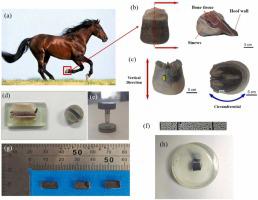Our official English website, www.x-mol.net, welcomes your feedback! (Note: you will need to create a separate account there.)
Structural and mechanical characterization of the hoof in Mongolian equids
Micron ( IF 2.4 ) Pub Date : 2024-02-21 , DOI: 10.1016/j.micron.2024.103609 Nuo Chen , Xin Yang , Shucai Xu , Jiafeng Song
Micron ( IF 2.4 ) Pub Date : 2024-02-21 , DOI: 10.1016/j.micron.2024.103609 Nuo Chen , Xin Yang , Shucai Xu , Jiafeng Song

|
In this paper, the microstructure and mechanical properties (including nanoindentation, tensile test, and compression test) of Mongolian horse hooves were investigated. Many tubules and Intermediate Filaments (IF) were distributed longitudinally in the hoof of Mongolian horses, which could better help the hoof cushioning. The hardness and modulus of the hoof wall of Mongolian horses varied at different water contents. The hardness and modulus decreased with the increase in water content. The modulus of elasticity of the hoof wall decreased from 16.3% to 25.4%, and the hardness decreased from 17.8% to 29.3% from 10% to 20% water content. At 20–30% water content, the horseshoe wall modulus decreased by 3.5%−4.8%, and the hardness reduced by 4.1%−7.3%. The results of the tensile and compression experiments showed that the compression properties of Mongolian horse hooves were better than their tensile properties; their longitudinal compression energy absorption was better than their transverse compression properties; and Young's modulus and yield strength of the hoof wall increased as the compression rate increased. Finally, comparing the experiments belonging to this paper with hooves from other papers, it was found that the hardness of the tubular region and the intertubular region of Mongolian horse hooves was 17.7% and 39.4% higher than that of the hooves from the current study, respectively. The microstructural features of Mongolian horse-like hooves with superior mechanical properties provide a promising inspiration for the bionic design of lightweight and high-strength composites in engineering.
中文翻译:

蒙古马科动物蹄的结构和力学特征
本文对蒙古马蹄的微观结构和力学性能(包括纳米压痕、拉伸试验和压缩试验)进行了研究。蒙古马的蹄内纵向分布有许多小管和中间丝(IF),可以更好地帮助蹄部缓冲。蒙古马蹄壁的硬度和模量随含水量的不同而变化。硬度和模量随含水量的增加而降低。含水量10%~20%时,蹄壁弹性模量从16.3%下降到25.4%,硬度从17.8%下降到29.3%。当含水量为20%~30%时,马蹄壁模量下降3.5%−4.8%,硬度下降4.1%−7.3%。拉伸和压缩实验结果表明,蒙古马蹄的压缩性能优于拉伸性能;其纵向压缩吸能性能优于横向压缩性能;蹄壁的杨氏模量和屈服强度随着压缩率的增加而增加。最后,将本文的实验与其他论文的蹄进行比较,发现蒙古马蹄的管状区和管间区的硬度比本研究的蹄高17.7%和39.4%,分别。蒙古马蹄的微观结构特征及其优越的力学性能为工程中轻质高强复合材料的仿生设计提供了良好的启发。
更新日期:2024-02-21
中文翻译:

蒙古马科动物蹄的结构和力学特征
本文对蒙古马蹄的微观结构和力学性能(包括纳米压痕、拉伸试验和压缩试验)进行了研究。蒙古马的蹄内纵向分布有许多小管和中间丝(IF),可以更好地帮助蹄部缓冲。蒙古马蹄壁的硬度和模量随含水量的不同而变化。硬度和模量随含水量的增加而降低。含水量10%~20%时,蹄壁弹性模量从16.3%下降到25.4%,硬度从17.8%下降到29.3%。当含水量为20%~30%时,马蹄壁模量下降3.5%−4.8%,硬度下降4.1%−7.3%。拉伸和压缩实验结果表明,蒙古马蹄的压缩性能优于拉伸性能;其纵向压缩吸能性能优于横向压缩性能;蹄壁的杨氏模量和屈服强度随着压缩率的增加而增加。最后,将本文的实验与其他论文的蹄进行比较,发现蒙古马蹄的管状区和管间区的硬度比本研究的蹄高17.7%和39.4%,分别。蒙古马蹄的微观结构特征及其优越的力学性能为工程中轻质高强复合材料的仿生设计提供了良好的启发。



























 京公网安备 11010802027423号
京公网安备 11010802027423号